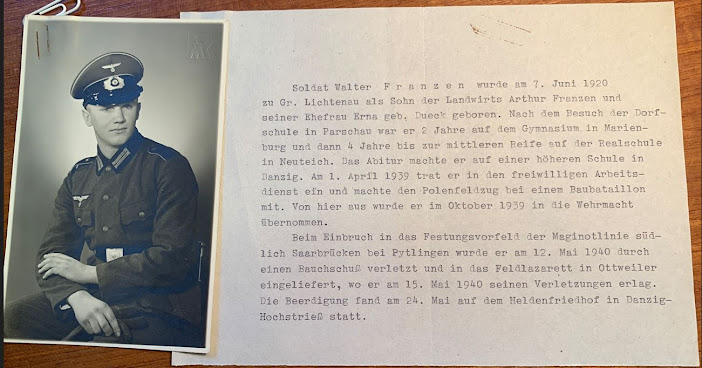I have yet to visit the former Mennonite congregations in
Poland; it is on my bucket list. And when I do it will done with great
humility. Poles suffered greatly because of Nazi Germany. Prussian Mennonites
sided firmly and enthusiastically with the racial politics of the Reich and its
goals for a reorganized Europe under German leadership.
Here is the Sunday program for the 1941 Rosenort Mennonite Heldengedenktag:
Day of Commemoration for Heroes, March 1941 (Third Sunday of Lent). In addition, the file has
other write-ups and photos of fallen congregational members for the
denominational paper (below).
The congregation's lead pastor (Elder) Ernst Regehr had been
a Nazi Party member since 1931. This was not unusual for Prussian Mennonite
congregations, and there was nothing in a decade to temper their enthusiasm.
In 1941 the Rosenort cemetery had a large memorial stone for twenty-one fallen congregational soldiers in World War 1 (see pic); likely that was destroyed in World War 2. But in 1941 with the victory over France complete, this Mennonite congregation was ready to celebrate and honour--even in their grief--the sacrifice of their dead and especially of their Führer.
The sermon (pic below) leaves no doubt: Hitler is perceived by Regehr and his Mennonite community as an amazing gift of God. I have attached only a partial translation of Regehr's sermon.
As the sermon continues, he freely intermixes quotes from scripture and from Hitler. Those who preach semi-regularly in Mennonite congregations today, may rightly ask: What in the world has happened
here? Regehr knows scripture well and the congregation is generally pious and
doctrinally orthodox.
In the post-war years Regehr was again elected as elder in Uruguay, where many Danzig-Prussian Mennonites fled and resettled (note 1).
It is a sober part of our history, especially for those with a family connection to West Prussia in the twentieth century. It is also an opportunity for the "healing of memories."
---Arnold Neufeldt-Fast
---Notes---
Source: "Stoff für den Mennoniten Gemeindekalender
1941," Box 1, 1-7, Nachlaß Abraham Braun, Mennonitische Forschungsstelle
Weierhof.
Note 1: See Mark Jantzen articles in GAMEO, https://gameo.org/index.php?title=Regehr,_Ernst_(1903-1970);
also https://gameo.org/index.php?title=Rosenort_Mennonite_Church_(Rosenort,_Pomeranian_Voivodeship,_Poland).
A German translation is found in MennLex V, http://www.mennlex.de/doku.php?id=art:regehr_ernst.
See multiple previous posts, including: https://russianmennonites.blogspot.com/2023/05/danzig-west-prussian-mennonites-as-nazi.html; ALSO https://russianmennonites.blogspot.com/2023/01/holocaust-remembrance-day-january-27.html; ALSO https://russianmennonites.blogspot.com/2022/09/prof-benjamin-unruh-and-mccs.html.










Comments
Post a Comment